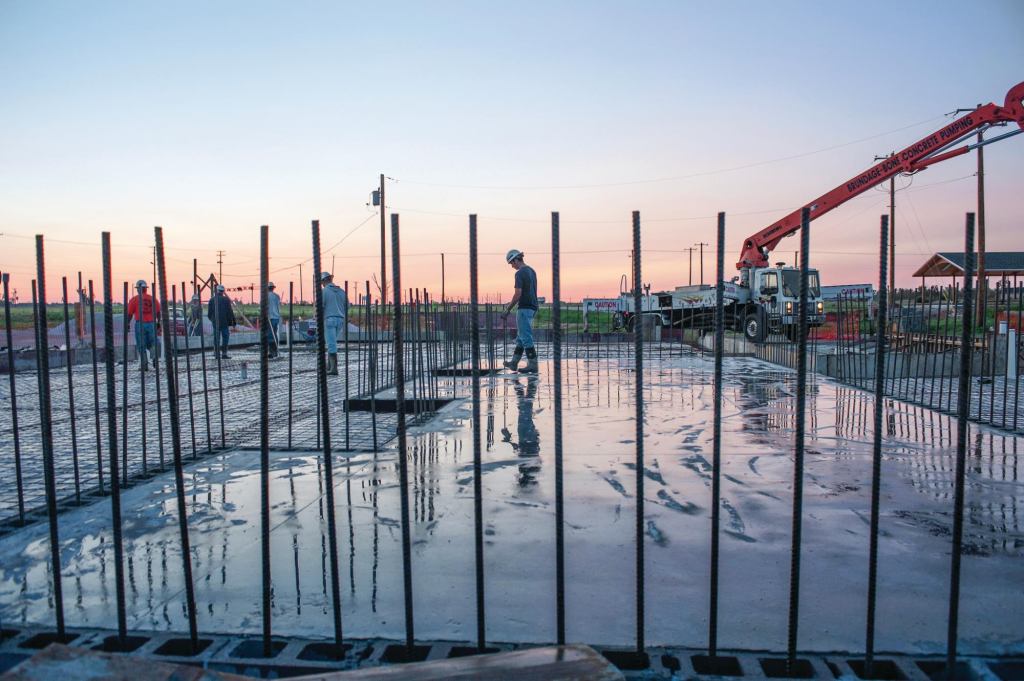Picture this: You’re relaxing at home on a Sunday afternoon about half past five, when you hear the sirens wail: tornado warning. You look to the west, but you don’t see a funnel cloud—just a towering black curtain across your field of view, like a big thunderstorm. You peer into the darkness. As the screen of rain pushes past you, the sky lightens. But then you hear the sound: a rumble, a roar, like an enormous freight train. Trees start to thrash around, shingles fly off a nearby roof, and you realize: “It’s a tornado. It’s a big tornado. It’s a—huge—tornado.” Then your windows blow in.
You shout to your family, you dive into the closet, or the bathroom, or under the kitchen table. The roar doubles, and quadruples, and rises in pitch until it sounds like a giant locomotive and a jet engine at the same time—so loud that you can’t hear the sound of your house coming apart. But you can feel the floor shuddering, lifting, and dropping. You tremble and pray. The sheer terror goes on and on: five minutes … 10 minutes? When will it end? And then the wind passes away, as suddenly as it came.
You crawl out from under the wreckage. The fragments of structure that just saved your life are all that is left. Your roof is gone. Your possessions are gone—blown away. In their place are the scrambled, shredded remnants of other people’s stuff, and bits of their houses. You have the clothes on your back—jeans? A bathrobe? You’re barefoot.
You look around—your neighbors’ homes are gone, too. The trees on your street are stripped and toppled; only the shattered stumps are left. For 10 blocks around you, everything is pulverized. You check yourself, your family, your pets: Are they alive? Are they hurt? There is no shelter; there are no lights. And it’s raining, and it’s hailing—ice-cold rain, and big, hard hail. It’s eerily quiet. There is no sound of traffic. But you hear dozens of smoke alarms: beep, beep, beep … ruptured gas lines are flaring into flame. And you hear neighbors, trapped or injured, crying for help—or just crying.
What do you do?
If you’re in Joplin, Mo., you do what Joplin did—what Joplin does. You get up and go to work.
The record-setting tornado that ripped through Joplin on May 22, 2011, left a mile-wide scar across the city. In Google satellite view, it’s a brown curve across the green landscape, like a giant Nike swoosh. Zoom in, and you can see blue tarps on roofs, and the splintered debris strewn across block after block. But the streets are already clear—and anyway, that satellite photo is a year old now; by mid-August, most of that mess was already pushed to the curb, snaffled up by giant FEMA grapples, dumped into monster trucks, and carted off to a landfill in Kansas.
The brown scar in the Google maps image is only a memory now—fresh and alive, for sure, but still, just a memory of last year. This year, there’s healing, and instead of tarps, there are fresh new roofs, and sprinkled among the bulldozed lots you’ll now find floors, frames, shells, brand-new houses. Drive down almost any street today, and you’ll hear hammers and saws. Next to a bare patch of gravel, you’ll see fresh sod. The splintered stumps are still around, but you see a lot of saplings too.
And when this writer traveled to Joplin this spring, the people I met there still cried—every one of them—but more often, they smiled.
The tornado scraped away the surface of Joplin. But underneath, there was more Joplin: heart and soul, muscle and bone. This is not the story of how an F-5 killer tornado crushed a town. This is the story of how an F-5 killer tornado could not crush this town.
Best Laid Plans
Crystal Harrington is the executive director of the Home Builders Association of Southwest Missouri (the HBA for Joplin and vicinity). On the day the tornado came, Crystal was working on her association’s top problem: the economy. Hoping to persuade local business leaders to support home building in Joplin, she had commissioned an impact study by NAHB economist Elliot Eisenberg. Eisenberg was due to fly into Joplin Sunday evening. Harrington had lined up early morning interviews for him with local radio and TV stations, followed by breakfast with local builders. After a mid-morning press conference, lunch would be at the country club with all the local elected officials, including state representatives. After some brief down time in the afternoon, dinner would be with the full HBA membership.
“Elliot was going to make us look good,” says Harrington. “We scheduled all that for Monday, the 23rd of May.”
It was not to be.
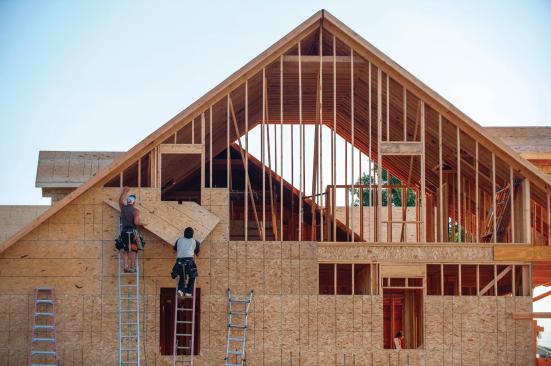
Chris Usher
On Sunday afternoon, Harrington was at her office taking care of last minute details. At 5 p.m., her husband Bob called: “You better turn your TV on, and watch the weather.” Then the sirens sounded. Harrington hid in the bathroom at the back of her office while the storm passed—a near miss.
The HBA office on 32nd Street was a mile south of the tornado’s track; Crystal’s husband, daughter, and grandson were at home, a mile or two north of it. “Usually it’s a six-minute commute from door to door,” she says. “It took me three hours to get home.”
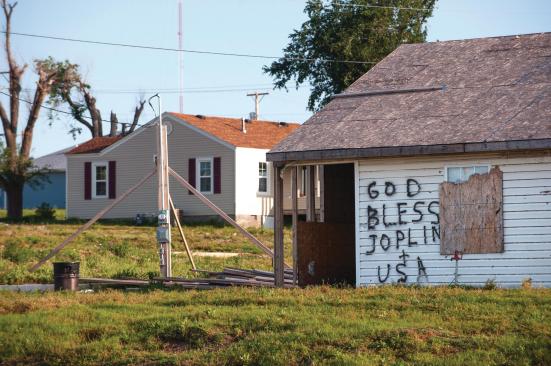
Chris Usher
North-south roads were all blocked. Taking a short-cut behind St. John’s Hospital on 26th Street, Harrington saw that the building’s windows were all blown out. Cars were blasted into jumbled heaps in the parking lots. Doctors and nurses were evacuating injured patients and staff, and trying to set up emergency operations outdoors.
She made her way west to Main Street and turned north. “That’s where I started to see paramedics trying to pull people out of cars, and people being loaded on pickup trucks at the hospital and carried to Memorial Hall where they had set up a triage station. I asked two ladies who were walking barefoot in the street, ‘Can I help you? Is there someplace I can take you?’ and they said, ‘No. There’s nowhere to go.’”
Nobody, Harrington realized, was going to come hear Eisenberg talk about the economy the next morning. “And I figured the hotel would probably give his room away. So many people were going to need shelter.” She got through to Matt Morrow, the HBA executive officer in Springfield, Mo., who had helped her arrange Eisenberg’s visit. “I said, ‘You gotta stop Elliot. Joplin has been hit by a really bad storm. We’re in trouble.’” Morrow said to her, “I’ll take care of Elliot. Do what you have to do.”
Back at her house, Harrington’s family was sitting in her blacked-out house, eating ice cream. They didn’t know about the tornado. “But pretty soon they came after my husband,” says Harrington. “He’s the director of facilities at the university, and he’s on the emergency preparedness team.” Bob Harrington went away to run a Red Cross shelter at Missouri Southern State University. He would not sleep at home for days.
Bob’s previous job had been facilities manager at St. John’s Hospital. Over 30 years, he had overseen the construction of most of its buildings. The tornado took the 10-story hospital out—totaled it. The hulk is still there, but it’s no longer usable. It was several weeks, says Crystal, before Bob could make himself go look at it.
At the emergency operations center, Bob joined up with a team led by top city officials. “Our fire chief lost his home,” says Crystal. “He parked his wife and kids with family, said ‘Stay there,’ and he went to work, in 20 minutes. The director of public works crawled out of the rubble of his house with his wife, got her to his daughter’s house, and went to work. That’s what all these people did, they went to work.”
Pulling Together
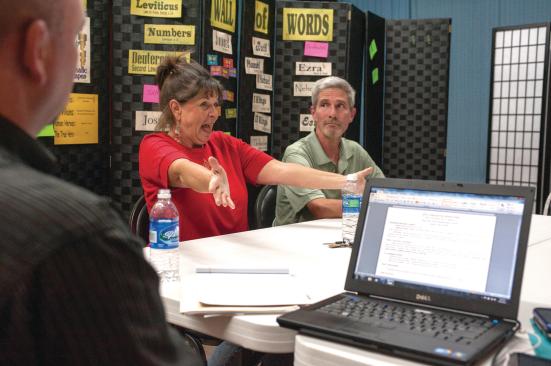
Chris Usher
Buckling Down Born and raised in Joplin, Kansas City builder Judy Stanley is working to rebuild the homes of her brother Brian (shown), her sister, Diane Huddleston, and their parents.
Crystal introduced me to Steve Cope, Joplin’s building inspector. Like everyone at City Hall in Joplin, Cope is a busy man. But he generously sat and talked with me for a while.
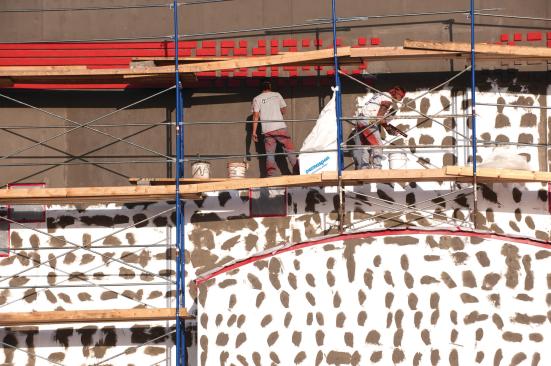
Chris Usher
Workers stucco a new office building near the Huddlestons’ house.
On Sunday afternoon, May 22, 2011, Cope had gone to see the high school graduation (his daughter plays in the band). “Afterwards we went on home and heard the sirens go off, and we were out on the porch, watching it get darker and darker.” TV reported a tornado, and then the radio reported that a fire station had been hit.
Cope went to his office, got a city truck, and went to take a look. Driving south through an older neighborhood of small houses and large, mature trees, Cope approached St. John’s Hospital from the north. He saw the ruined tower and the jumble of wrecked cars. “From then on,” he says, “we didn’t stop or slow down for the next week or two. We were working around the clock.”
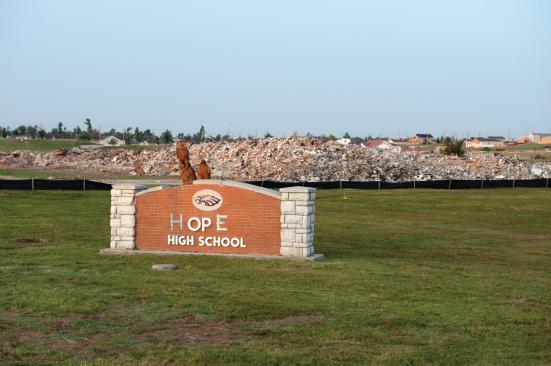
Chris Usher
The old sign for Joplin High School bears a new message.
The early hours were all improvisation, says Cope. “Within an hour, other cities were bringing equipment in. And local people who had equipment were just showing up. Everybody just did what you needed to do. Nobody cared what your job was—it was, ‘You got a truck?’ ‘Yeah.’ ‘It’s got a radio?’ ‘Yeah.’ ‘Okay, you go this way.’ It was cool. I mean, that’s why it is where it is today.”
Within days, however, the city was implementing a structured response—with help from state and federal emergency managers. FEMA took on the monumental task of debris clearing, on an expedited schedule.
In typical disaster responses, explains Cope, FEMA will pay for clean-up—but only after the city has paid to get the work done. “There’s no way the city had that kind of money,” Cope says—“or even the state.” In Joplin, FEMA and the Army Corps of Engineers hired contractors to clear streets and pick up debris from the curb, and paid the cost directly. “I think it’s a good way to do it,” says Cope, “because you could easily break a city. We couldn’t have hired all those contractors.” The catch: After 60 days, the city would have to start paying the tab.
As the flow of local rebuilding traffic threatened to impede the heavy equipment brought in by the Corps’ contractors, the city decided to put a moratorium on construction in the worst-hit damage zone. The 60-day moratorium was unpopular with some residents who wanted to roll up their sleeves and start building right away. But a year later, I didn’t find anybody who thought it was a bad idea in retrospect. There was plenty of repair work outside the ground-zero stripe of peak devastation; and the moratorium was lifted on a rolling basis as sections of the damage zone were cleared. “It was easier to work after the streets were cleaned up,” says Cope. “And we actually released the whole area well ahead of our two months, because they got in there and got the stuff out.” Plus, the city was off the hook for the cost.
Overnight, it was boom times in Joplin. In April 2011, Cope’s office released March permit figures: three permits for new houses in all of Joplin. In July, Joplin issued 1,570 permits for residential and commercial work, with a total value of more than $51 million—$18 million more than the total permit value for all of 2010. Cope started to see builders he had never met before. “Many of them are still here,” he says. “We let them all know that if they want to work here, they need to get a license from the city. That way I know they at least have insurance.”
In the weeks following the disaster, nearby communities sent building officials to help with the crush of work, and City Hall staffed up. Outside Cope’s office door in the open-plan, fourth-floor office shared by the city’s departments of Planning and Public Works, Cope introduced me to one of the newer staff members, hired six months earlier: Meri Stewart, a clerk in the engineering department. Before the storm, Meri, her husband Scotty, her son Nick, and their dog lived in a one-story house a block from Dillon’s grocery (now a vacant lot). When we met in April, they were living in a FEMA trailer out by the airport, north of town.
A Temporary Life
Sitting in the living room of their FEMA trailer, Meri and Scotty tell me their story. Meri had to work the weekend that the tornado hit Joplin. Back then she was a clerk at the city jail. She worked a night shift on Saturday, went home Sunday morning, and woke up around 5 in the afternoon—a little early. Her Sunday night shift didn’t start until 9 p.m.
Scotty, a Marine Vietnam War vet, says, “I was in the garage, and I had my radio on. I heard them say to take cover. And by the time I got from the garage to the back of the house, and got ahold of her—she had just woken up. She wanted to get in the bathtub, but I said ‘No.’ I grabbed her, put her on the ground, and put this memory-foam mattress over the top of her.” He snapped his fingers: “And that quick, it happened.”
Sitting at their computer, Meri showed me photos on her Facebook page of the wreckage of their home. She pointed at the crumpled 4-inch foam mattress among the splinters and rubble. “That’s what I was under,” she says. Meri got off with a few scratches. But Scotty, who had been on top of the mattress, had three cracked ribs, a bruised lung, and a deep gash on his wrist from a falling beam.
“If she had gotten in the bathtub, she’d have been gone,” Scotty says. “The tub, the whole bathroom was gone. And where we were lying, there was nothing but the rug on the floor.” All the walls in that half of the house blew away. “We got up and got oriented, and I looked across the street to my buddy’s house,” says Scotty. “It was gone. It was just a concrete slab.”
It was raining. “I got a jacket on her—that jacket right there on the chair—and I got her into a neighbor’s house that still had a partial roof on it, and I went looking for the dog and trying to help people,” says Scotty. “And that’s when I realized I was hurt—I couldn’t do anything.”
Meri’s son Nick, who graduated from Joplin High School this May, was at a friend’s house across town. As the storm approached, waking her, she had called him to see if he was all right. “As we were on the phone,” she says, “I heard glass breaking nearby and then I could hear our windows breaking. I said, ‘Nick, the house is crumbling.’ He said, ‘What do you mean, the house is crumbling?’—and the phone went dead.” After the storm, she says, “he came and found us, and we were crying because we couldn’t find our dog. He put me in his car and said, ‘Mom, I’ll find her.’ And he went through the house and found her. She was okay.”
The night before the tornado, a good friend and classmate of Nick’s had spent the night at the Stewart home, leaving after breakfast. Lantz Hare, a free-style bicycle athlete, never got home on Sunday: The tornado pulled him from his car and killed him. Family, friends, and police searched for four days before finding his body.
Help arrived. Someone took Scotty and Meri to the makeshift trauma center at Memorial Hall. “Scotty has COPD (chronic obstructive pulmonary disease),” says Meri. “He didn’t look good, and he wasn’t breathing good, and they wanted to send him to Kansas City or Tulsa. They were going to either fly him, or send him by ambulance. And he wouldn’t go, because they told him there wouldn’t be room for me.” Instead, the medics put Scotty and Meri on a bus to Springfield, where Scotty spent six days in the hospital. Meri slept in a recliner by his bedside.
FEMAville is bleak, featureless, and dreary: row after row of plain white house trailers set in a gravel parking lot. It looks more like a detention center than a housing area. I drove through it with Crystal Harrington on my first Monday in town. She told me, “We asked them, didn’t they want to landscape it a little, put in some trees and stuff? They said, ‘No, we don’t want people to like it here. This is not their home.’”
Meri says, “A representative from FEMA visits every month, and they want to know how we’re doing in searching for homes. And they make that very clear, every time they come—this is not permanent.” But finding another house is tough. The tornado ripped out a significant fraction of Joplin’s rental inventory. Most of those rental units were not insured; many may never be replaced. FEMA supplies a list of leads, but so far, Meri and Scotty have found either that the units are already rented, or the rent is out of their reach—“or they don’t accept pets,” says Meri.
So every morning, Meri wakes up in a spare, basic trailer sitting in a gravel parking lot. She drives to City Hall and works all day at a desk in a cubicle helping other people get into their new houses. And every night, she drives back to her trailer. It has been an ordeal.
I opened my laptop and looked up Meri’s former address, near the Dillon’s grocery, on Google maps. From the air, Google satellite view shows the post-storm scene: scraped lots, scattered debris, and blue tarps. But Google street view still shows Meri’s neighborhood the way it looked before the storm: green lawns, small houses, rose and lilac bushes, big trees.
I show Meri the image of her house, the way it used to be. “Yup. That’s it,” she says quietly. Tears welled up in her eyes.
After I left town, I learned that Meri and her family were on the list for a Habitat for Humanity house—one of the 30 houses in the Governor’s Challenge, to be paid for with Community Block Grant money and built by local builders, with help from popular sports teams. The St. Louis Rams are going to help build Meri a new house; the builders broke ground in June. By next year, the Stewarts’ year in the drab, forlorn FEMA village will be like the tornado scar through Joplin—just a fading memory of lives interrupted, loss, and loneliness. But when I left Meri’s trailer, Meri did not know that yet.
Meri said to me, “We stood up, and there was nothing. There were 161 people killed. We could have been 162 and 163. But by the grace of God, we’re here.”
“It’s a roof over our head, and God provided it for us,” says Scotty. “This is not a home for us. But it’s our home for now.”
A Better Building?
When I met Cope, Joplin’s building inspector, I asked him whether codes have changed since the storm. That whole topic area scares Crystal Harrington, she told me; her fear is that the tornado could become the rationale for a raft of costly new rules, in a town where most of the housing stock that needs replacing is valued at under $100,000.
But in fact, officials have called for only a few, relatively minor, building code changes. Cope says he could see examples on the periphery of the storm track where improved connections might have helped. In one case, he says, a whole garage roof had been lifted off the walls and set in the street, otherwise intact. A better connection between the roof trusses and the wall plates might have saved the building, he suggests.
But Cope says a tornado like the May 22 storm is a special case—something you can’t build for. “We can design for the pressure of wind,” he says. “But when the wind takes a Volkswagen and flies it into your house—we can’t design something that will stand up to that. At least, not something anybody could afford.”
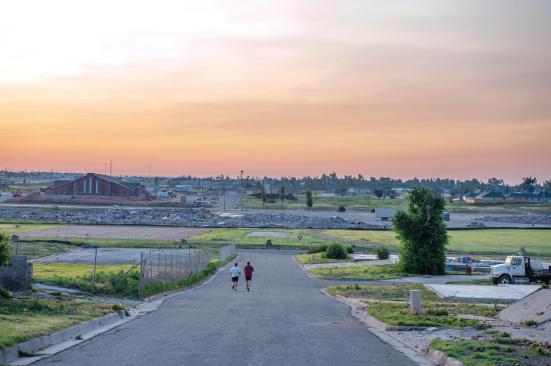
Chris Usher
Rising from the Rubble Where Joplin High School used to stand, a pile of bricks and metal now sits. Lying in a designated flood plain, that location will become the new ball fields for the Joplin Eagles when the new school is built on a nearby rise.
Tornado experts agree. I asked Tim Reinhold, the director of engineering with the insurance industry–funded Institute for Business and Home Safety (IBHS), about tornadoes and codes. Reinhold is a top national expert on the topic—at Clemson University, he directed a research team that tore apart houses to evaluate connection methods, and he oversees a giant wind-tunnel facility in South Carolina that can subject whole buildings to hurricane-force winds. IBHS research and analysis has helped to justify tougher wind-resistant building codes all along the Atlantic and Gulf Coast hurricane zone. But even Reinhold says tornadoes are a different animal.
“I can’t look anybody in the eye who just lost their house in an F-4 or F-5 tornado, and tell them, ‘Well, if you did this or did that, it would have saved the house,’” Reinhold tells me. “We have no reason to believe that.” Comparing the experience of different houses doesn’t teach very much, he says: “If I look at two houses side by side that went through the same hurricane,” he says, “it’s reasonable to say that they experienced the same wind forces. But tornadoes are so violent and turbulent—we don’t know what the wind forces are from one point to the next inside a tornado.”
After the storm, builders and code officials discussed what changes to the code might be appropriate. They settled on some modest upgrades: a requirement for hurricane clips at every rafter or truss, closer spacing between reinforced cores in block foundations, and closer spacing between anchor bolts where sills attach to foundations.
But most of the homes destroyed in the tornado were older buildings, dating from the ’70s, ’60s, or even the ’50s and ’40s. I had to wonder whether homes built to more recent codes would not have fared better—and perhaps even saved some lives. And one building in particular continued to pique my interest: a dentist’s office at South Jackson by 26th Street that, when I visited in April, was still standing as it had stood the day after the storm—mostly destroyed, but, an optimist might say, partially intact. It was one of the few tornado ruins in town that was still standing, and that a passerby could still inspect.
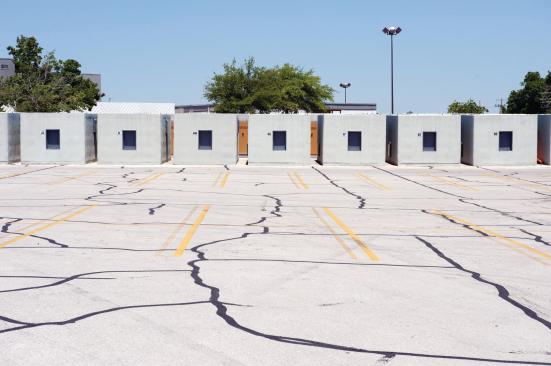
Chris Usher
Defensive Line At the temporary high school in a repurposed mall building near Joplin’s Ridgeline Drive, a set of tornado shelters stand shoulder to shoulder, ready for the next storm. Had school been in session at the old high school on May 22, 2011, much of the student body might have perished.
As I looked at the building, I saw elements that could have contributed to its strength. The roof pitch was steep, and the trusses were braced along the length of the roof. Trusses were 16 inches on center—a sign that, as Tim Reinhold suggested, the building was probably built to the International Building Code (IBC) rather than the less stringent International Residential Code (IRC). It may even have been engineered, at least in part.
Rooms on the main level were trashed. Windows were blown in, chairs and desks tumbled around, dentist equipment wrecked. Those spaces plainly offered no shelter. But the first-story walls were mostly standing, and the main floor was intact. And underneath was a walkout basement with room in the back where the wind had not reached—where dozens of people could have taken cover. (The garage doors opened directly onto the former site of the Greenbriar nursing home, which had collapsed in the tornado, killing 11 elderly residents.)
Investigating, I heard that the ruined dentist’s office was still undemolished because the owner, who has serious health problems, was in a dispute with his insurance company. But then I learned that on the day of its destruction, the nearly new building had served one last useful purpose: A desperate family had indeed sheltered in its basement during the storm. I followed up. And that is how I met the Huddleston family. In April when I visited, the Huddlestons were rebuilding their ruined house—scarcely a block away, just across 26th Street on South Sergeant Avenue, two or three houses down.
In the Teeth of a Tornado
When I walked into the Huddleston’s new house, it was almost finished. Kenny Huddleston was on his hands and knees grouting tile, while Dianne Huddleston cleaned the tiles with a rag. Outside, Dianne’s sister Judy Stanley, a Kansas City home builder, was organizing volunteers (the house is a testament to Stanley’s skill and resourcefulness). Dianne stopped work for a few minutes (and Kenny sort of paused), to tell me their story.
Kenny and Dianne have five kids. The oldest son, Taylor, is married with a child of his own. The second son, Joe (18), graduated from Joplin High School the day the tornado struck. The whole family went to graduation that Sunday at Missouri Southern State University.
“As soon as they announced Joe’s name, Taylor and his wife Andrea said goodbye and headed on back to our house with their baby,” says Dianne. At the end of the ceremony, Joe went to a friend’s house. Dianne and Kenny got into the family Suburban and headed home, with their 9-year-old twins, Michael and Maggie, and 13-year-old Emily in the back. “We headed west on 7th,” says Dianne. “But the radio started saying there was a tornado on the ground in Riverton—which if you went straight out 7th Street, you’d hit Riverton. So I said, ‘Kenny, get off 7th, we have to go south.’”
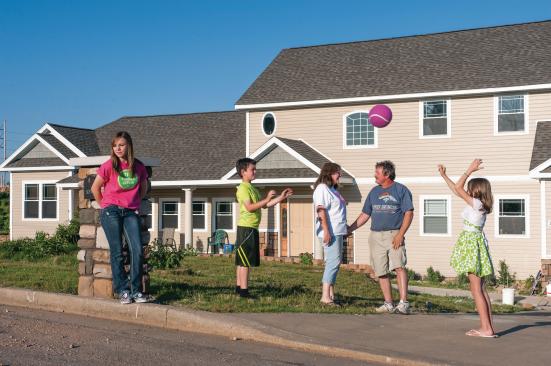
Chris Usher
Home at Last The Huddleston family at their newly completed house (left to right: Emily, Michael, Dianne, Kenny, and Maggie).
The family drove south on Indiana Street, drove past the high school (which the tornado would soon destroy), and turned west on 26th Street. “The reports on the radio were still saying Kansas—Riverton, Galina … they weren’t talking about here,” says Dianne. “But we could hear the sirens, and it kept getting darker.”
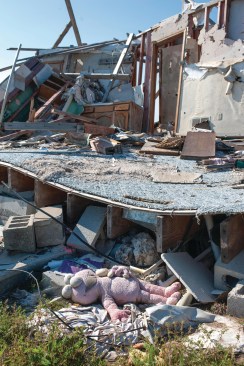
Chris Usher
Part of a destroyed house near the old high school, acquired by the school district as part of the rebuilding plan.
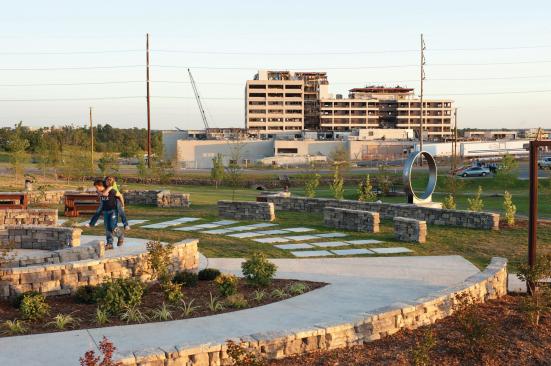
Chris Usher
The ruins of St. John’s Hospital viewed from the rebuilt Cunningham Park.
“We came to the stop light up here,” says Dianne, pointing east, “where Taco Bell used to be. There was a truck stopped at the light. And at that point, we didn’t see a tornado. It was dark. It was stormy. The wind was blowing, and we knew we needed to get home quick. But we were just a few blocks away. And where else do you go, on a Sunday afternoon?” As the signal changed, Kenny passed the truck and raced for home and the safety of the basement. They could see the wall of rain approaching and a few sticks blowing in the wind, but they still didn’t expect a tornado—just a heavy thunderstorm. But then they hit the dark wall.
“Just past the elementary school,” says Dianne, “something busted out the back window of the Suburban.” The glass blew onto one of the 9-year-old twins. “Michael grabbed Emily’s hand, and that was about it. We started getting hit with so much debris. Bricks, rocks, pieces of house hitting you … ” Says Kenny: “It was like riding a roller coaster while somebody hits you with a baseball bat.”
The Suburban flew. “We landed up here at the end of our street,” says Kenny. It was hard to tell—“how high did we go?” Dianne wonders—but the Suburban seems to have traveled a quarter mile through the air. “The last thing I remember seeing was the power poles snapping off up at the top of the hill, and the transformers popping,” says Dianne. “And one of the poles slammed into the side of the Suburban.” The car came to rest, wedged under a bent-over roadside advertising sign, as the power lines whipped it and wrapped around it.
“A power line—that could have been what happened to Emily’s leg,” says Dianne.
When they got out of the car, the twins and the parents had lacerations, puncture wounds, and bruises from small flying debris. “We were beaten up,” said Dianne. But 13-year-old Emily was grievously injured—flayed open from hip to knee. “Her left leg had a huge gash all the way to the bone,” says Dianne.
In the rain and hail, they looked around. “There was nothing,” says Dianne. “The nursing home was gone. There were cars spinning on their tops, everywhere was devastation, and we were standing in the middle of it, and it was—‘What are we going to do?’ To look out there, I thought: We are on our own.”
Tripping over wires, Kenny tried to carry Emily, but he couldn’t use his left side. So Emily leaned against him and hopped on her good leg, and they made their way to the only standing shelter in sight: the dentist’s office on South Jackson.
“The garage doors were blown out, and there were some cars in there. And first we leaned her against a car, but we knew she had to get laid out and we needed to evaluate where she was,” says Dianne. They went further back into the dark cave of the basement. “It was a clear space, and it was dry,” says Dianne.
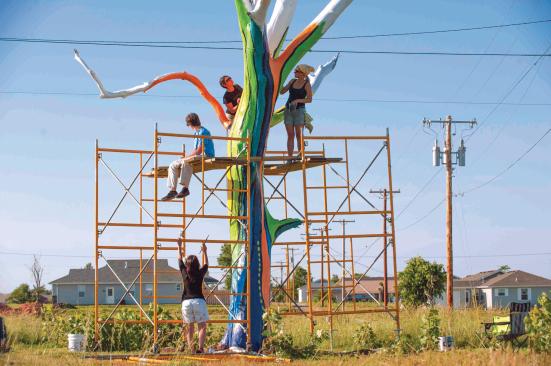
Chris Usher
Dreams, Wings, and Beautiful Things Across a range of media, Joplin's artists have chronicled the community's rekindled hope and optimism. Above, artists paint a tornado-damaged tree in rainbow colors.
Dianne stayed with Emily and the twins. Kenny left to walk to their house and get their other car. Taylor and his wife and their son, along with several neighbors, were okay—they had hidden in the cellar. But the house was blown down; the garage and the car were gone. Next door, Dianne’s parents’ car was crippled—smelling of gas, and with a 2×4 through the radiator. Neighbors told Kenny that he could use their car, parked by the nearby elementary school. So he got that car and went back to the dentist’s office. But Dianne and Emily were already gone. “I left the twins there,” says Dianne, “because I knew he would be back.”
Kenny spent hours walking around town, searching for his wife and daughter. It would be close to dawn before they finally got back into contact. “And in the meantime, he trekked the whole town,” says Dianne, “and he saw a whole world of things that I didn’t see—that I don’t think were very pleasant.” An auto mechanic with his own shop in Joplin, Kenny knows a lot of people in town. “I finally ran into somebody who works at Freeman [Hospital], who told me that they were shipping them out to different hospitals, and that there was no list,” he says.
While Kenny was searching for a car, Taylor had gone to the dentist’s office to help. “I was ripping through dental supplies, trying to find something to cover Emily’s wound, because it was open and bleeding,” says Dianne. “I could find dental floss and toothbrushes … ,” she laughs. “I did find some of those bibs that they use, that I sort of laid over it. And Taylor went up to the top of the hill to see about St. John’s.” Then a nurse came in who was on her way to work and had heard that somebody in the basement was injured.
“She looked at me and said, ‘Are you her mother?’ and I said ‘Yes,’” says Dianne. “And she said, ‘You stay with her. Don’t leave her.’ And I felt like I was going to be saying my goodbyes to her.” The nurse put a tourniquet on Emily’s leg and moved on.
Lying in the basement, Emily would later write, “I kept closing my eyes, for longer periods of time each time, it was really the easiest thing to do, when I did everything was calm, peaceful, and painless, the last time I closed my eyes is when I felt it, the calmest touch ever … then I heard this voice, the voice of an angel, she told me ‘Everything is going to be okay.’”
A neighbor came in, and Dianne said, “Will you carry her?” Together they went out to the street and up the hill. A passing truck saw them and stopped. “We got in the back of the truck, and we left,” Dianne says. They went to St. John’s, where hospital staff were still evacuating their own patients from the wrecked building. “A nurse grabbed her, put her on a gurney, put an IV on her, and said, ‘She needs to go to Freeman. She needs help, but we can’t do anything.’”
At Freeman, the gurney turned out to matter. “They rolled us right into the ER,” says Dianne. “And we got there early, because they gave her a blanket. They ran out of blankets. And then we waited, and waited, and they finally put us in an ambulance to Parsons, Kansas.” At 4 a.m., Dianne finally got through to Kenny on the cell phone to tell him where they were.
Emily had two surgeries and two blood transfusions, spending 11 days in the hospital. It took weeks of physical therapy for her to learn to walk after her injury; and for weeks, doctors were still removing small bits of debris from her wound on routine follow-up visits. But this spring, she went out for track—and ran a 7:30 mile. “She made National Junior Honor Society,” says Dianne. “She just doesn’t quit. For 13 years old … she’s the strongest little girl I know.”
Emily writes: “I am so glad that I went through what I did. It made me a stronger person and made me understand a lot more. People keep asking me if I wish I would of went with Taylor and Andrea when they left from graduation early instead of sitting back down, but I don’t, if I would of then Michael or Maggie would have been where I was in the car and I couldn’t even imagine seeing them hurt. Like I told my mom, everything happens for a reason. The only thing that bugs me now is all the mean comments and looks I get over my scar, but honestly, this is who I am now, its a part of me, I’m very proud of my scar and I don’t care what others think.”
Coming Home
The night before I left Joplin, I had dinner with Crystal and her husband Bob, along with builder Charlie Kuehn and his wife Pam.
Charlie had attended the high school graduation the afternoon of the tornado. Hearing the sirens, he had packed his whole family—wife, kids, in-laws, the entire group—into his truck and headed south. At a roundabout between The Home Depot and the Walmart, he considered heading west on 26th Street—the route the Huddlestons took—but he changed his mind and kept going south to 32nd Street. In the driving rain, he bombed past the office where Crystal was hunkered down. “Did you see my truck?” she asked him. “No,” he said. “We were traveling at a high rate of speed.”
I asked Kuehn if he had any reason for choosing a slightly southerly path—a route that spared his family the fate that the Huddlestons encountered. “No,” he said. “It was just a guess. I couldn’t see anything.”
It was about this time that I finally grasped something that Dianne Huddleston had said to me. “We all went through the same tornado,” she said. “But there are 6,000 different stories. Nobody saw the same thing.”
Each tornado story is deeply personal. But the people of Joplin are bound together now by the shared experience of having been through that thing together. And when they meet, they share the stories. “If you see somebody who you haven’t seen since before the tornado,” says Crystal, “you have to ask them—what happened? Is everyone all right? And, of course, sometimes the stories are very sad. And if you find out that everyone is okay, it’s such a relief.” They talk about it every day; and often, there are tears—as there were at dinner that night.
I heard many stories in Joplin, and I heard them one at a time. But at the time of the tornado, in the real world, they all happened at once. While Steve Cope was watching the warnings at his house, Crystal was hunkered down in her office. Charlie Kuehn was peering through his windshield as he drove past. The Huddlestons were driving straight into the wall of wind, and Scotty and Meri Stewart were diving for cover. And thousands and thousands of other people were facing their own moment of fear and reaction. And now, more than a year later, all at once, and all together, the people of Joplin are building their lives back.
“So you go through that together,” says Crystal, “and then afterwards you come out on the other side, and you know you made it through it, and everybody’s … closer. But—you don’t go back too often.”
Learn more about markets featured in this article: Manhattan, KS.
